ATI Radeon X800 GTO Mini Roundup: Sapphire, Connect3D, and PowerColor
by Josh Venning on December 26, 2005 12:05 AM EST- Posted in
- GPUs
Overclocking/Load Power
No doubt that many have heard the rumors of the GTO2's overclocking abilities, but you can be assured that they aren't completely unfounded. There has been much talk of how this card is capable of being modded from its standard 12 pixel pipelines up to 16 pipelines, which, when combined with clock speed boosts, make it capable of performing the same as an X850 Pro for a ridiculously lower price. While, in all honesty, this is technically possible, changing the pipes requires meddling with the BIOS, which is a good way to ruin your card. So, we've decided to focus solely on overclocking the engine and memory clock speeds. We would also like to add that you should only overclock your card at your own risk, as there is always a possibility for damage to occur if not done with care.
Note that we weren't able to overclock the X800 GTO Ultimate because the fan-less heat sink means that there is a much greater risk of damage to the card due to heat. We found that this card has so far taken the lead as being the most screamingly hot card to touch after running a few tests on it. This is unfortunately the price of silent operation, and those in very hot climates or with computer cases that have poor ventilation may run into cooling problems with this card.
We also weren't able to get much of an overclock on the PowerColor X800 GTO 16, which isn't very surprising given that it comes with 16 pixel pipelines enabled. The fact that these extra pipelines are enabled for this card seems to greatly reduce its overclocking headroom below other X800 GTOs. We were still able to overclock the card a little more, for an engine clock of 440MHz and memory clock of 500MHz. This wasn't enough to help the PowerColor X800 GTO 16 match either the Connect3D or the Sapphire GTO2 in performance when overclocked, however.
When we came around to seeing the kind of overclocking that the X800 GTO2 could do, we were indeed impressed. It turns out that the card has the ability to overclock, and we managed to get it to run stable with a core clock speed of 525MHz and a memory speed of 582MHz. This gave us some fairly impressive gains in framerates in Splinter Cell over the standard factory clock of 400Mhz and 490MHz, as you can see by the graph(s). (Note that on the graph, ATI Radeon X800 GTO represents the X800 GTO at reference clock speeds.)
Load Power
No doubt that many have heard the rumors of the GTO2's overclocking abilities, but you can be assured that they aren't completely unfounded. There has been much talk of how this card is capable of being modded from its standard 12 pixel pipelines up to 16 pipelines, which, when combined with clock speed boosts, make it capable of performing the same as an X850 Pro for a ridiculously lower price. While, in all honesty, this is technically possible, changing the pipes requires meddling with the BIOS, which is a good way to ruin your card. So, we've decided to focus solely on overclocking the engine and memory clock speeds. We would also like to add that you should only overclock your card at your own risk, as there is always a possibility for damage to occur if not done with care.
Note that we weren't able to overclock the X800 GTO Ultimate because the fan-less heat sink means that there is a much greater risk of damage to the card due to heat. We found that this card has so far taken the lead as being the most screamingly hot card to touch after running a few tests on it. This is unfortunately the price of silent operation, and those in very hot climates or with computer cases that have poor ventilation may run into cooling problems with this card.
We also weren't able to get much of an overclock on the PowerColor X800 GTO 16, which isn't very surprising given that it comes with 16 pixel pipelines enabled. The fact that these extra pipelines are enabled for this card seems to greatly reduce its overclocking headroom below other X800 GTOs. We were still able to overclock the card a little more, for an engine clock of 440MHz and memory clock of 500MHz. This wasn't enough to help the PowerColor X800 GTO 16 match either the Connect3D or the Sapphire GTO2 in performance when overclocked, however.
When we came around to seeing the kind of overclocking that the X800 GTO2 could do, we were indeed impressed. It turns out that the card has the ability to overclock, and we managed to get it to run stable with a core clock speed of 525MHz and a memory speed of 582MHz. This gave us some fairly impressive gains in framerates in Splinter Cell over the standard factory clock of 400Mhz and 490MHz, as you can see by the graph(s). (Note that on the graph, ATI Radeon X800 GTO represents the X800 GTO at reference clock speeds.)
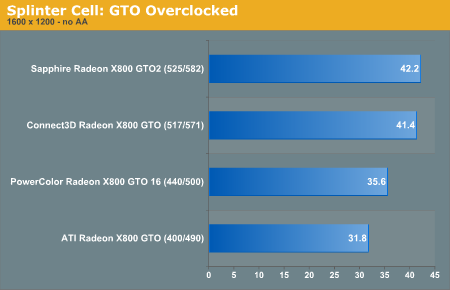
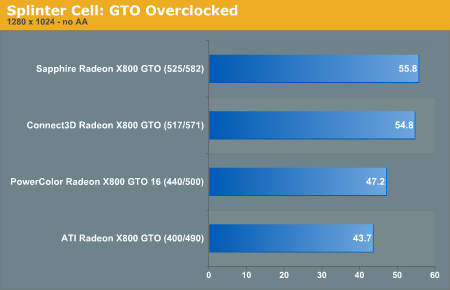
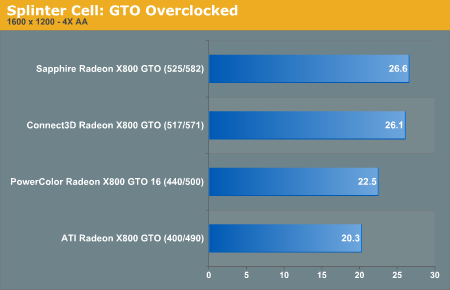
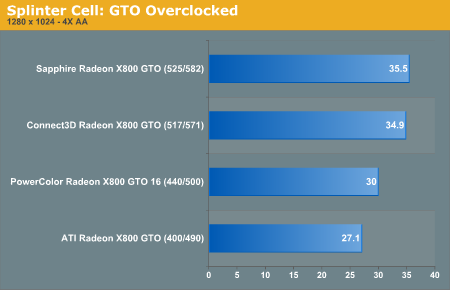
Load Power
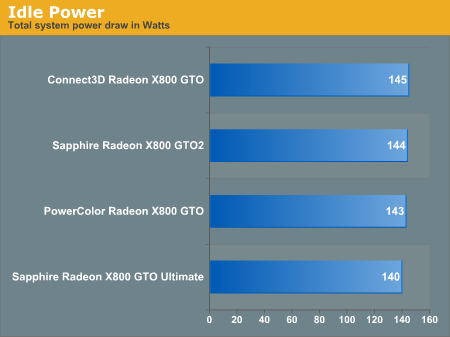
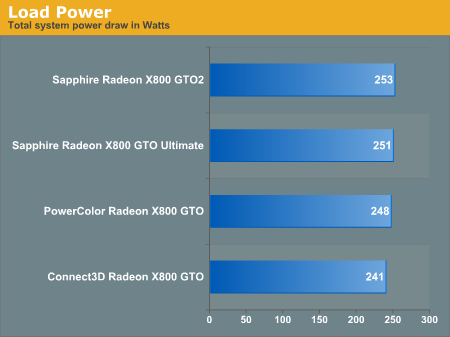










27 Comments
View All Comments
Le Québécois - Monday, December 26, 2005 - link
Is it just me or the PowerColor GTO 16 has the exact same spec as the standart ATI Radeon X800XL?AtaStrumf - Monday, December 26, 2005 - link
Almost. X800XL runs at 400/500 vs. 400/490 of the GTO 16. They also both use the same .11 mikron R430 chip.mamisano - Monday, December 26, 2005 - link
Wow, you guys are getting really soft lately. The GTO2's main claim to fame is the ability to unlock the 4 extra pipelines and the tremendous overclocking headroom available. At least give it a try, it can always be flashed back if you experience problems.Second, did you actually remove any of the HS units to determine the actual core installed on each card? That and a list of brand/speed of memory used on each one would have been very beneficial to the overall review.
Seems to be another in a line of reviews with decreasing quality.
AtaStrumf - Monday, December 26, 2005 - link
I absolutely agree! Very low quality review and VERY, VERY late!!!Zoomer - Monday, December 26, 2005 - link
I research all of these cards before settling with the c3d gto - and I would have gotten the gto2 if it was avaliable.Sapphire GTO2
R480
Samsung 1.6ns
C3D GTO
R423
Samsung 2.0ns
PowerColor
R430
Samsung 2.0ns
An article at anandtech commented on why the Powercolor card (the R430) can't hit high clocks - although it uses a smaller process, the 130nm uses a low k process. The 110nm process does NOT. The article goes on to say that this shrink was to cut costs, at the expense of clock speed.
However, it is interesting to note that the die shrink didn't do anything to reduce power draw. An investigation into the voltages the R430 is running at is in order. :)
One more thing to note - the c3d has VIVO, with a rage theatre chip soldered (as usual) on the board.
I can't remember the ones for ultimtate, but the fireblade should also be using 1.6ns rams.
tuteja1986 - Monday, December 26, 2005 - link
I wonder why anandtech never did it earlier ;(coldpower27 - Monday, December 26, 2005 - link
At least the different manufacturer made it interesting, and customized the boards a little bit to differentiate from one another and not stick to the reference design.The 6800 GS is quite the competitor for the X800 GTO, and from my persepctive is a better buy if you want something straight out of the box save for the Powercolor X800 GTO 16. Though there is also the XFX Edition clocked at 485/1100 to worry about.